
Chyromyidae are small to very small cyclorrhaphous, acalyptrate flies (Diptera) currently classified within the Heleomyzoidea by most authors. The majority have a pale yellow integument and bright iridescent green, red or purple eyes. The family is represented in all continents except Antarctica. There are about 150 named species in this family worldwide. There has been no comprehensive taxonomic study to elucidate the generic limits of species in the family. Currently, only four genera are recognised, but ongoing studies of the African species indicate that there are more.

Platycheirus clypeatus is a species of hoverfly. It is found across the Palearctic and in the Nearctic. The larvae feed on aphids. Adults are usually found on the edges of woodland or scrub, heath or along hedgerows where they visit a wide range of flowers.

Tipula hortorum is a species of cranefly which is widespread throughout the West Palaearctic.It is a woodland species.

Tipula unca is a species of cranefly.

Platycheirus immarginatus, the Comb-legged Sedgesitter, is a common species of hoverfly. It is found in parts of northern Europe and northern North America.
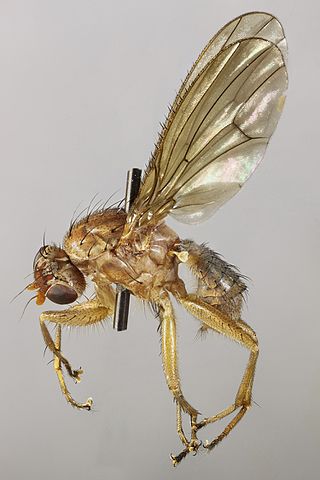
Suillia bicolor is a Palearctic species of Heleomyzidae. The sctellum is covered with light, fine, scattered hairs. The wing venation is characterized by the presence of small spines on the costal vein. The first pair of legs of the male has the first tarsal segments equipped with a spike of a triangular shape and a width smaller than the width of the segment. The female's abdomen has a seventh segment that is longer than the sixth. The reproductive organs of females have three irregularly jagged, cylindrical in outline, seminal receptacles narrowly curled at the apex. For terms see Morphology of Diptera.

Canace nascia is a European species of Canacidae.
Dipteran morphology differs in some significant ways from the broader morphology of insects. The Diptera is a very large and diverse order of mostly small to medium-sized insects. They have prominent compound eyes on a mobile head, and one pair of functional, membraneous wings, which are attached to a complex mesothorax. The second pair of wings, on the metathorax, are reduced to halteres. The order's fundamental peculiarity is its remarkable specialization in terms of wing shape and the morpho-anatomical adaptation of the thorax – features which lend particular agility to its flying forms. The filiform, stylate or aristate antennae correlate with the Nematocera, Brachycera and Cyclorrhapha taxa respectively. It displays substantial morphological uniformity in lower taxa, especially at the level of genus or species. The configuration of integumental bristles is of fundamental importance in their taxonomy, as is wing venation. It displays a complete metamorphosis, or holometabolous development. The larvae are legless, and have head capsules with mandibulate mouthparts in the Nematocera. The larvae of "higher flies" (Brachycera) are however headless and wormlike, and display only three instars. Pupae are obtect in the Nematocera, or coarcate in Brachycera.
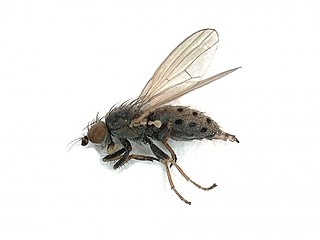
Chamaemyia flavipalpis is a species of fly in the family Chamaemyiidae. It is found in the Palearctic. and North Africa.

Morpholeria ruficornis is a species of fly in the family Heleomyzidae. It is found in the Palearctic.
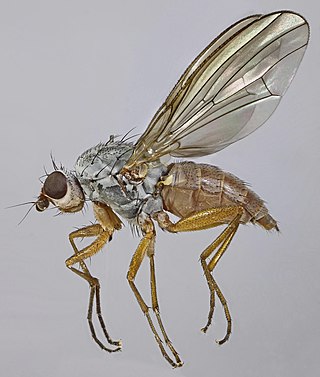
Tephrochlamys rufiventris is a species of fly in the family Heleomyzidae. It is found in the Palearctic. The body length is 5 to 6 mm. The head has both setae and bristles on the gena. The thorax is characterized by the presence of setae on the propleura, a bare prothorax and metathoracic setae in a 0+3 arrangement, with the first pair of suture setae lying closer to the suture than to the second pair. The posterior and anterior metathoracic setae are almost the same length, and the hairs between them are placed in more than four rows. The wings have short and monochromatic pterostigmas and spine-like bristles on the costal vein longer than the hair. The middle pair of legs has one well-developed spur on each tibia.For terms see Morphology of Diptera.

Elgiva cucularia is a species of fly in the family Sciomyzidae. It is found in the Palearctic. Long. : 5–8 mm.Overall it is coloured yellowish-brown with a bluish-gray body. The head is characterized by silky black dots at the bases of the anterior orbital setae, between the bases of the antennae and the edges of the compound eyes, and in the centre of the occiput. The third antenna segment is a little shorter than the second. The mesonotum is black with a grey ground and grey pruinosity.There are longitudinal, brown stripes on the dorsum of the thorax: two narrow in the middle and two wide on the sides. One mesopleural bristle amongst short setae.The prothorax is bare. The yellowish smoky wings are 5.2 to 6.8 mm long and have fuzzy spots on the front half. The legs and abdomen are yellow. The lower surfaces of the hind femora are equipped with setae, while the front pair lacks them.The abdomen is rufous.For terms see Morphology of Diptera. Larvae of E. cucularia are predators of aquatic, pulmonate snails in the families Lymnaeidae, Physidae, and Planorbidae.

Fannia mollissima is a species of fly in the family Fanniidae. It is found in the Palearctic. For identification see

Fannia rondanii is a species of fly in the family Fanniidae. It is found in the Palearctic. For identification see

Heleomyza serrata is a species of fly in the family Heleomyzidae. It is found in the Palearctic.
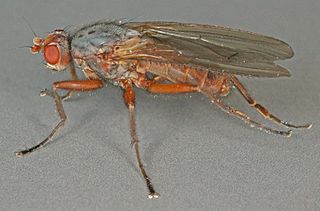
Scoliocentra villosa is a species of fly in the family Heleomyzidae. It is found in the Palearctic . This species was described in 1830 by Johann Wilhelm Meigen as Helomyza villosa [1].

Heteromyza rotundicornis is a species of fly in the family Heleomyzidae. It is found in the Palearctic.
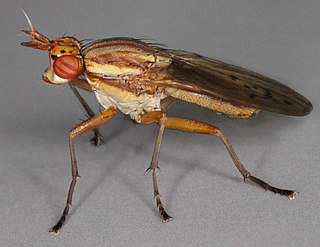
Ilione albiseta is a species of fly in the family Sciomyzidae. It is found in the Palearctic. The body length is 8 to 11.2mm and the basic colour is yellowish-brown. The spot on the occiput, the spots at the base of the frontal orbital setae and the almost triangular spots at the edge of the eyes at the height of the antennae are silky dark brown. The long antennae have a whitish hairy arists. There are longitudinal, brown stripes on the yellowish-dustedmesonotum : two narrow in the middle and two wide on the sides. In addition, there is a brown band on the body below the notopleura. The prosternum is bare. Chaetotaxy of the thorax shows strong presutural acrostichal setae and 2–3 well-developed subalar setae. The wings are 6.8 to 8 mm long and usually have 5 marks: on the anterior transverse vein, the medial vein, and the two ends of the posterior transverse vein. If there are only 2 dots on the medial vein, the transverse veins are at least darkened. The legs are yellow with darkened tarsi. The lower surfaces of the femora of the hind legs are equipped with strong and dense setae in males, and with short and sparse setae in females. Males are characterized by a copulatory apparatus with non-swollen abdominal pituitary glands.For terms see Morphology of Diptera. The larva preys on Galba truncatula

Limnia unguicornis is a species of fly in the family Sciomyzidae. It is found in the Palearctic.
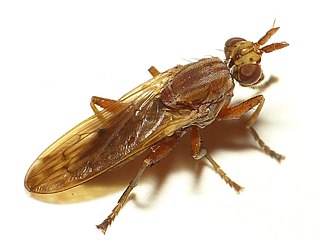
Elgiva solicita is a species of fly in the family Sciomyzidae. It is found in the Palearctic



















